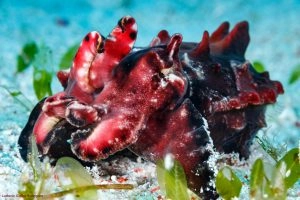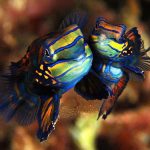
Cephalopods are some of the most impressive invertebrates in the sea. Members of the class Cephalopoda, which includes squid, cuttlefish, octopuses, and nautiluses, have captivated humans for centuries—and for a good reason! You will be able to find in this group the squid, the inventive mimic octopus, the nautilus, the venomous blue-ringed octopus, etc…
Today, we want to shout out to a cephalopod that doesn’t always get the credit it deserves, especially while we’re meeting him in Komodo! The captivating creature has a mix of pink, yellow, brown, and orange colours. Many are unaware of how picturesque it is.
It’s Pfeffer’s flamboyant cuttlefish, Metasepia pfefferi is one of the smallest cuttlefish growing up to 8cm in length. It is the prettiest of the species making it a favourite subject for scuba divers and underwater photographers.
Native to sandy habitats in the Indo-Pacific Ocean, the flamboyant cuttlefish (Metasepia pfefferi) only reach 7 cm in size.
Fact 1: They aren’t good swimmers!
Like all cuttlefish, they have a ‘cuttlebone’ that they use for buoyancy. Unlike many of its relatives, the flamboyant cuttlefish prefers to “walk” along the seafloor rather than swim. It uses two arms and fins to make leg-like appendages to creep across the seafloor. This behaviour, called ambling, is only seen in one other cephalopod—the paint pot cuttlefish. In Komodo, you can see some dive sites with Dragon Dive Komodo.
Fact 2: They squirt ink!
Like other cuttlefish, the flamboyant uses its ink to deceive predators. It will eject ink into the water to form an ink cloud while it swims to safety. However, it’s a tiny squirt!
Fact 3: They could kill you, so be aware!
They are the only species of cuttlefish known to have any poisons, and they carry a unique toxin in their muscles.
Fact 4: They die after copulating!
Like other cephalopods, the flamboyant cuttlefish breeds once and then dies. The female lays her eggs one by one and attaches them to the roof of the cave, and dies shortly after. The female will hide eggs in crevices or on ledges in coral, rock, or wood, or even the odd coconut shell (seen on a BBC video)!
Fact 5: Top active predators!
They are known to be active predators, hunting a variety of small crustaceans and molluscs.
Fact 6: Dad is the keeper of the species.
They have a unique reproductive process, with females laying eggs in batches, which the male guards.
Fact 7: Be amazed when you see some of them!
The flamboyant cuttlefish is considered to be a very rare species and is protected by international conservation laws.
We are lucky and proud to have them in Komodo National Park waters. So join us during April and May to discover this astonishing species.








